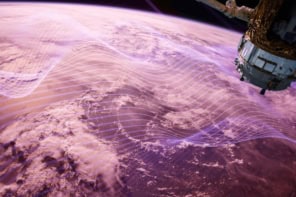
The first images of thunder, created by visualizing the sound waves created by artificially triggered lightning, have been taken by an international team of researchers. The novel experimental approach provides an entirely new way of investigating lightning, which may help to answer outstanding questions about the physics that underlies this intense natural phenomenon.
Although bolts of lightning strike the Earth more than four million times each day, much of the specific physics behind this process remains a mystery. “While we understand the general mechanics of thunder generation, it’s not particularly clear which physical processes of the lightning discharge contribute to the thunder we hear,” says group leader Maher Dayeh, of the Southwest Research Institute in the US, who developed the new method together with colleagues in Australia and the US. Dayeh explains that some outstanding questions include how lightning is initiated, what controls its movement through the atmosphere, and how it strikes objects near the ground.
Forked leaders
Lightning strikes begin with the build-up of electrostatic charges in storm clouds – these form channels of negatively charged, ionized air, or “leaders”, which fork downwards. When they reach the ground, these leaders create a bridge of low resistance, through which discharge can occur – with positive charge racing up the channel in a series of nearly instantaneous return strokes. “When lightning does strike something, very large currents flow, heating up the channel to about 27,760 °C. The hot channel rapidly expands, making the thunder that we hear and can measure,” explains Joseph Dwyer, of the University of New Hampshire, who is part of the team. He adds that because “the thunder is created close to the time that all this is happening, it provides a window into what’s going on when lightning strikes”.
As lightning’s unpredictable nature makes it difficult to study in the field, the researchers conducted their experiments on artificially triggered strikes instead. To generate lightning, the team launched small rockets into storm clouds as they passed overhead. The rockets had long, trailing copper wires attached – these provided a conductive channel through which lightning would predictably strike – onto which the team could focus their instruments.
Lightning rockets
The rockets were launched from the International Center for Lightning Research, which is based in Florida in the US. The centre’s location takes advantage of the state’s record high frequency of lightning strikes, with the geography of the Florida peninsula promoting the formation of warm, humid updrafts, which generate very active thunderclouds at high altitudes.
To record the acoustic signature of thunder, Dayeh and colleagues designed a large array of 16 microphones, each spaced one metre apart. These were lined up 95 metres from the launch pad where the lightning would hit. Following each strike, post-processing and directional-amplification techniques were used to convert the recordings into a vertical acoustic profile of the lightning bolt. With sound waves from higher up in the atmosphere taking longer to reach the receivers, each return-stroke signal has a characteristically curved appearance. In their study, the researchers imaged strikes with at least nine separate return strokes and found that the loudest part of the thunderclap comes from where the bolt meets the ground.
Craig Rodger – a physicist at the University of Otago in New Zealand who was not involved in this study – commends the work for offering a new way to investigate lightning, which he expects will lead to interesting new knowledge. “Even now, we are learning totally new things about lightning and the processes that take place during a discharge,” he says.
With their proof-of-concept study complete, Dayeh’s team is now working on refining its technique to better explore the outstanding mysteries around lightning generation. One potential avenue of investigation, for example, would be in triggering lightning with a more natural, zigzag appearance – rather than the straight form created by the wires in the current set-up. From this, they might distinguish between the different components of lightning – current pulses, discharge-channel zigzags and step-leader branches – and analysing their acoustic signals independently.
The research was presented earlier this week at the 2015 Joint Assembly, and is due to be published in Geophysical Research Letters.



